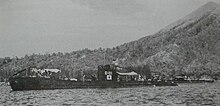Japanese submarine Ro-110
Completed and commissioned in July 1943, she served in World War II, operating in the Indian Ocean.
[1] For surface running, the boats were powered by two 500-brake-horsepower (373 kW) diesel engines, each driving one propeller shaft.
[4] On 3 December 1943, Ro-110 departed Penang to begin her first war patrol, tasked with raiding Allied shipping in the Indian Ocean.
[4] She attacked an Allied convoy in the Bay of Bengal southeast of Madras, India, on 14 December 1943 with a spread of torpedoes, damaging one ship.
[4] The damage forced her to head back to Penang, where she arrived on 19 December 1943 and her commanding officer claimed to have sunk one ship.
[4] At 04:20[5] on the day Ro-110 attacked the convoy, a submarine torpedoed the British 4,807-gross register ton armed merchant ship Daisy Moller 3 nautical miles (5.6 km; 3.5 mi) off India's coast in the Eastern Ghats region.
[8] The submarine's crew then machine-gunned the survivors in the water[4][8] before also machine gunning the men aboard the life rafts.
[4] One source claims that 55 of Daisy Moller′s 71 crew members died in the sinking and subsequent massacre, and that of her 16 survivors, 13 came ashore on the Indian coast in the Krishna River delta at midnight on 17 December 1943 after drifting 80 nautical miles (150 km; 92 mi) to the south-southwest, that fishermen rescued three others from the wreckage of a lifeboat 6 nautical miles (11 km; 6.9 mi) offshore in the same area later on 17 December, and that all 16 survivors were picked up at Masulipatam on 18 December 1943.
[4] On 11 February 1944,[11] Ro-110 attacked Convoy JC-36 — which was bound from Colombo, Ceylon, to Calcutta, India — in the Bay of Bengal 200 nautical miles (370 km; 230 mi) northeast of Madras.
